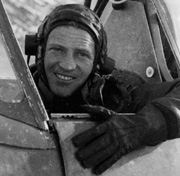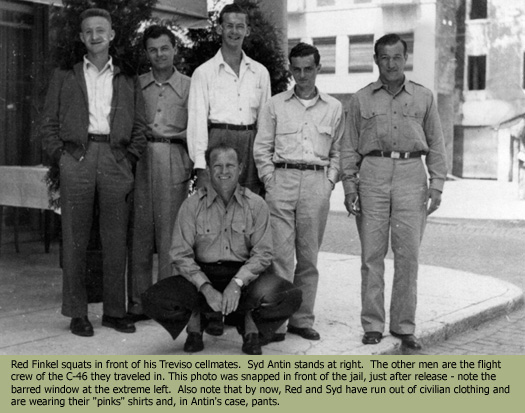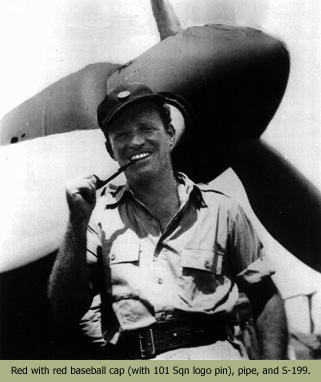 Aaron "Red"
Finkel
Aaron "Red"
FinkelBrooklyn, New York
Combat Record
No kills, but he did wreck Spitfire White 14 on landing. :)
Story
I have spoken with Aaron Finkel, Red, probably more than I have with any 101 veteran. No, he wasn't an ace. He didn't fly because he was a connaisseur of flight. And he wasn't so gung-ho about volunteering Israel, at least not before he was convinced. But Red is a character. He knows stories, and he likes to and knows how to tell 'em. And he serves as unofficial social co-ordinator of the surviving 101 pilots, at least in North America.
With that, let's get on with his story.
infantry
CBI
Amazingly, Finkel says that flying in WWII or for Israel, he never saw an enemy aircraft in the sky. He's either lucky or - if there were enemy planes up that he just missed seeing - very lucky.
In the spring of 1948, Finkel worked as a salesman of radio components. One night in early May, he was woken by a stranger sitting on his bed. He assumes his roommate let the man in, but has no idea who the guy was. The stranger tried to convince Finkel to fly for the Jews in Palestine and asked what it would take.
My thinking was that any Jews willing to stand up and fight for their life deserved all the help I could give them. So I told the man... that I'd do it for a bottle of whisky, cigarettes, and 30 dollars a month. (Yonay 1993)
Only days later, Finkel flew to Rome on a TWA Constellation unknowingly sitting next to future comrade-in-arms Syd Antin.
Finkel and Antin probably had the most eventful trip to Israel of all the 101 pilots. The two finished their S-199 training at Ceske Budejovice in early June and hitched a ride on a LAPSA C-46 leaving flying from Zatec to Israel with a planned stopover in Ajaccio, Corsica.
An iced-up carburetor forced the C-46 to set down early, at an Italian airbase at Treviso, in northern Italy. The base commander had previously proven friendly to Israeli aircraft crews and he had not bothered searching their planes for contraband cargo. Again this time, the base commander took the LAPSA captain's word that they were flying civilian cargo to the Americas - but when he left the area, one Italian soldier took his own initiative and peeked into the fuselage, where he saw Finkel and some crates. The soldier pointed a gun at Finkel and demanded that he open the boxes.
Finkel, thinking quickly, refused to do any such thing until the base commander returned and used the interim to collect any potentially incriminating docunents in the cockpit. Among the papers, Finkel found an envelope addressed to the 101 Squadron commander from Dr. Otto Felix, the Israeli contact in Czechoslovakia who met many arriving 101 recruits in Prague. The letter read: "Aaron Finkel. Typical American. Oversexed. To be watched."
(This seems an appropriate moment to relate my own Red Finkel story, summer 1999. I was speaking with him and Mitchell Flint at a poolside buffet in Palm Springs, Calif., when out if the blue a young lady of maybe 20 comes up and joins our conversation. I suspect her initial goal was to score some free food, but - honest to goodness - the 80-year-old Red almost charmed her right out of her towel.)
When the Italian commander and/or questora (regional chief of police) returned, he insisted that Finkel open a crate. The aircrew and passengers tried to convince the Italian authorities that the crates carried surveying equipment.
Now, anybody who has ever seen an ammunition box knows what the hell is in it. So they had a pretty good idea when they saw the ammunition boxes. The machine guns were in much longer boxes and they were in two layers. Even though we told them it was surveying equipment, they insisted on opening up the box. When they took the cover off, the top layer had the tripod for the machine gun and I think the sight or something else in there. But the guts of the machine gun were not in the top layer. When they saw the tripod, we tried to say, "See, that's for the surveying equipment." Understand, too, the language difficulty. It was tricky. Then the guy motions, "Open up the rest of it," and when we did, of course, there was that ugly air-cooled barrel - you couldn't call that surveying equipment. It was pretty obvious what it was.
See, they thought we were running guns for communists somewhere. It's what they were worried about - that's the word I got, anyway - and that's why they grabbed onto us and locked us up until they found out different. (Antin, pers. comm.)
Oops. The Italians decided to take crew and passengers into custody. Finkel asked to make a phone call and the Italians granted his request. He called Danny Agronsky, publicly the local LAPSA official and secretly in charge of the Haganah's European air operations. Upon completing his call, Finkel and the others from the C-46 were hustled toward the base jail. Finkel, Antin, and Don Kosteff, the C-46 pilot, shouted indignantly that they were Americans and could not be treated in such fashion. The Italians asked them if they wanted to see the US consul. As the US had maintained an arms embargo against the Middle East and any American citizen serving in the armed forces of another country could lose his citizenship, all three quickly declined, to the surprise of the Italians. Agronsky secured their release, but not before they had spent three nights in jail.
Oops. The Italians decided to take crew and passengers into custody. Finkel asked to make a phone call and the Italians granted his request. He called Danny Agronsky, publicly the local LAPSA official and secretly in charge of the Haganah's European air operations. Upon completing his call, Finkel and the others from the C-46 were hustled toward the base jail. Finkel, Antin, and Don Kosteff, the C-46 pilot, shouted indignantly that they were Americans and could not be treated in such fashion. The Italians asked them if they wanted to see the US consul. As the US had maintained an arms embargo against the Middle East and any American citizen serving in the armed forces of another country could lose his citizenship, all three quickly declined, to the surprise of the Italians. Agronsky secured their release, but not before they had spent three nights in jail.

Upon release from prison, the ex-cons went to a hotel in Treviso. They visited a house of ill repute that greatly impressed Antin:
You have never seen anything like it. It was a huge mansion-type thing - marble columns in the front, very ornate. It just represented all kinds of wealth. It was just as fancy as it could be. Inside, velvet drapes - it was just a beautiful mansion.
When we were released from the Italian prison there, they assigned a guard to stay with us, right with us, 24 hours a day. Well, we had to take him with us in order to go. We got in this place and sat down at these marble-top tables. They gave us cards, we played cards. They served us wine. The girls start trooping in one at a time dressed in very flimsy attire - the reason being obvious. We just went on drinking and carrousing, playing cards, playing with the girls, and one by one of course each of the guys picked one of the females to go to a room. Of course, the guard - we were feeding him a drink every time we had one and he got polluted. I mean he was really polluted. He finally passed out on the sofa. None of us got in that bad a shape like he, because we fed him whiskey intentionally.
Eventually, we had our fun and departed the place with him still passed out on the sofa. We went back to our hotel. We found out the next day that guy was reamed out when he went back to the prison. We never heard whether he was fired, or they had a firing squad, or what, but he did get in a lot of trouble, we did hear. (Antin, pers. comm)
From Treviso, the group took a steamboat to Venice (probably, Antin told me they took a steamboat "across the bay") in order to catch a flight to Haifa on a Jewish-owned South African airline that Agronsky had arranged.
We had gone through our good clothes and we were wearing all these parts of uniforms. We arrive in Haifa, the door of the aircraft is opened, and the first thing we see is a big, fat United States Army major, in full uniform with a UN armband around his arm. At that time, the UN had passed a requirement that no male of military age could be entered into Israel....
Well, this big, fat major interviewed each of us as we got off the aircraft. We all had a story. I had an uncle in Tel Aviv that I was gonna visit - I was a tourist. Now, try to convince anybody I was a tourist the way I was dressed, right? It was a laugh, but we had to say something and each of us had a different story. The fact is it was pretty damned obvious what we were there for.
Anyhow, they carted us off and put us in this fenced-in area that the UN had authority over and they confined us because we were not allowed to enter the country according to their rules. Anyway, during that very first night, the Israelis smuggled bodies in for each of us and smuggled us out. We were on our way to the Hundred-and-First Squadron by early morning. (Antin, pers. comm.)
Finkel doesn't remember exactly when he arrived, but it was after the Altalena incident.
 Once
Stan Andrews and Bob Vickman designed the red and black angel of death logo
for the 101 , the squadron decided it needed an identity, a calling card. Finkel
wrote his sister, Bea Novak, in New York and asked her to send him a package
of red baseball caps. Once they arrived, the squadron became known as the Red
Squadron and its pilots red caps became a mark of distinction on nights out
in Tel Aviv.
Once
Stan Andrews and Bob Vickman designed the red and black angel of death logo
for the 101 , the squadron decided it needed an identity, a calling card. Finkel
wrote his sister, Bea Novak, in New York and asked her to send him a package
of red baseball caps. Once they arrived, the squadron became known as the Red
Squadron and its pilots red caps became a mark of distinction on nights out
in Tel Aviv.
Like most of the 101, Finkel despised the "Messerschmitts". Once, he would have scrambled a S-199 to intercept in-bound aircraft, but when he pulled the starter handle, it came off in his hand.
Leo Nomis described Finkel as "composed, sandy-haired, quiet."
Finkel was quick to aid his fellows in danger. When Cyril Horowitz crashed a S-199 on Aug. 1, Finkel drove a jeep to the wreck and jumped out to pull him free of the wreck, risking the danger of an explosion. What he didn't know was the Horowitz was already standing safely away from the aircraft on the other side.
Finkel took part in Velvetta 2, flying with Jack Cohen (see Cohen's page for more info and click the first picture on this page for a great photo taken at Niksic) and had an uneventful trip.
On Jan. 2, 1949, Finkel and Sye Feldman took two Spitfires from Chatzor to attack rail traffic in Sinai. Feldman remembers:
We carried out a very successful ground attack on a troop train, just west of Al Arish. After strafing with cannon and machine-gun fire, we then bombed a railway junction. We returned a little early since Red's Spit was starting to overheat. (Cull et al 1994)

Two days later, Finkel destroyed a Spitfire. Finkel (in White 14) took off accompanied by White 12 for a late afternoon reconnaisance of Rafah. The pilots spotted and reported ten small vehicles on the Rafah-Gaza road and about 85 more heading southeast from Rafah to Al Auja. On landing at Chatzor, Finkel's Spitfire blew a tire. The plane skidded off the end of the runway and flipped on its back. While the plane was a mess, Finkel escaped shaken but unhurt. That would be his last combat sortie.
After the war, Finkel stayed long enough to help the 101 move to Ramat David, then left for home.